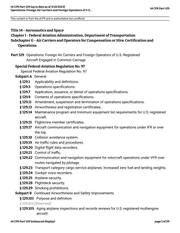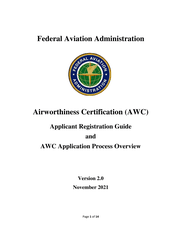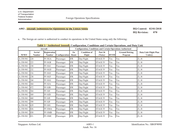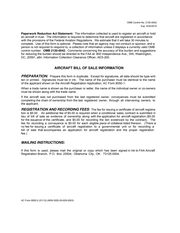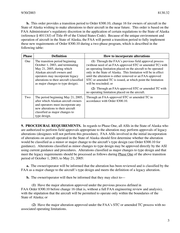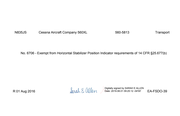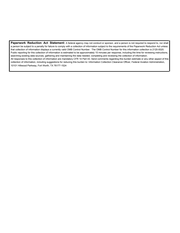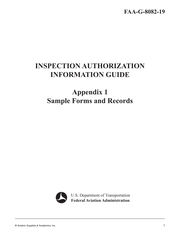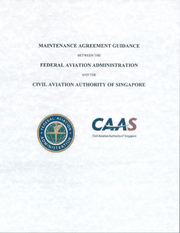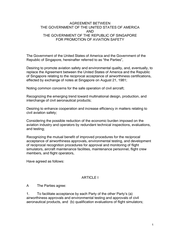FAA document for Singapore Airlines
| Tracking # |
AFAA-2024-00011 2023-07904 |
| Submitted | April 16, 2023 |
| Due | May 12, 2023 |
| Est. Completion | None |
MuckRock users can file, duplicate, track, and share public records requests like this one. Learn more.
Communications
From: Charlemagne Limage
To Whom It May Concern:
Pursuant to the Freedom of Information Act, I hereby request the following records:
During a preflight inspections the cabin crew tests and checks the battery, cabin, avionics, and cockpit for proper functioning and operation of an aircraft. Every pilot must make this final check to ensure the general integrity of their aircraft. Here’s a brief overview:
Cabin Inspection
The first step, check that you have the require paperwork. The acronym ARROW can help you remember the five documents you need to bring:
Airworthiness Certificate
Registration Certificate
Radio Station License (only required for operations outside the U.S.)
Operating Handbook
Weight and Balance Data
Legally, these documents and certificates must be inside the aircraft, and the airworthiness certificate needs to be on display where passengers can see it.
The second step:
Make sure the cockpit switches and valve toggles are in the right position.
Switch the battery on and record fuel gauge readings to compare to your visual inspection later.
Turn off the battery and make sure the magnetos are off.
Clean the cockpit of all trash and any unsecured tools and make sure your seatbelts aren’t fraying or loose.
If your plane has fuses, find the location and number of spares.
Exterior Inspection
All pilots should do a walk-around of their aircraft before a flight even if it was recently serviced and approved, it is always a good idea to double check all components. Pre-flight inspections ensure nothing is damaged or overlooked.
The Third step :
Look for loose rivets, bolts, nuts and safety-wired devices and any residue around these items.
Check brake pads and discs for thickness and look for rust and grooves.
Check tires for wear and flats by rolling the plane forward and backward.
Check oleo struts for proper inflation.
Test rigged controls for free movement with no chafing don’t forget to remove the control lock.
Make sure control hinge fasteners are secure.
Check the propeller for oil leaks, significant damage and loose blades.
Inspect the engine check oil levels and make sure air intakes are free of debris.
Check the exhaust pipe make sure it’s free of oil and black buildup.
Fuel system Check the fuel quantity and compare to cockpit gauges, look for correct octane color and debris and make sure fuel vents aren’t obstructed.
Drain sumps and sample fuel be sure fuel doesn’t keep dripping after.
Clean your windows, inside and out.
Review your aircraft’s performance data and emergency procedures.
Once you complete a thorough preflight inspection, you can take to the air with confidence.
Subject: PreFlight pilot checklist
1. I am making a request for pre- flight pilot checklist for international flight plan (FAA7233-4) from January 1, 2013 to November 31, 2013 for Singapore airline which is referred to "Singapore airlines Limited" and registration number: 9V-SKJ. Please provide me the pre- flight pilot checklist for Singapore Airline that came to John F. Kennedy international airport on January 1 2013 to November 31, 2013 .
Subject: seat Configuration.
1. Please be advised to provide me the major repair and alteration of airframe power plant propeller or Appliance. (FAA- form 337)from January 1, 2013 to November 31, 2013 for Singapore airline which is referred to ("Singapore airline Limited") and the registration number: 9V-SKJ.
2. FAA FORM 337 FAA Form 337, Major Repair and Alteration (Airframe, Powerplant, Propeller, or Appliance), serves two purpose. It provides: 1. Owners and operators with a record of major repairs and major alterations, indicating details and approval. 2. The FAA with a copy for the aircraft records. An example of a typical completed FAA Form 337 is provided in appendix 1, figure 2.
3.Airworthiness and registration certificates for Singapore Airlines which is refer to Singapore Airline Limited and the registration number:9V-SKJ.
This is the FAA rules:
129.13 Airworthiness and registration certificates.
(a) No foreign air carrier may operate any aircraft within the United States unless that aircraft carries a current registration certificate and displays the nationality and registration markings of the State of Registry, and an airworthiness certificate issued or validated by:
(1) The State of Registry; or
(2) The State of the Operator, provided that the State of the Operator and the State of Registry have entered into an agreement under Article 83bis of the Convention on International Civil Aviation that covers the aircraft.
(b) No foreign air carrier may operate a foreign aircraft within the United States except in accordance with the limitations on maximum certificated weights prescribed for that aircraft and that operation by the country of manufacture of the aircraft.
AIRCRAFT CERTIFICATIONS
The FAA issues different certifications for aircraft depending on their purpose. The maintenance requirements for these different types of uses vary, so it’s crucial to know which one you’re applying for and how to keep up with the right maintenance:
Standard Airworthiness — The FAA approves applications for a standard airworthiness certificate if your registered aircraft complies with one of the following aircraft categories: normal, commuter, utility, transport or acrobatic. You must also maintain a condition that’s safe for operation, as well as conduct preventative maintenance — any modifications you make to your aircraft must meet the requirements of 14 CFR Parts 21, 43 and 91.
Special Airworthiness — The FAA issues special airworthiness certificates for primary, restricted, multiple, limited, experimental, provisional and special flight aircraft. To qualify for this certificate, your aircraft must meet several standards detailed in 14 CFR Part 21, 45, 48, 91 and 375, as well as policies that specify additional aircraft maintenance requirements.
The requested documents will be made available to the general public, and this request is not being made for commercial purposes.
In the event that there are fees, I would be grateful if you would inform me of the total charges in advance of fulfilling my request. I would prefer the request filled electronically, by e-mail attachment if available or CD-ROM if not.
Thank you in advance for your anticipated cooperation in this matter. I look forward to receiving your response to this request within 20 business days, as the statute requires.
Sincerely,
Charlemagne Limage
From: Muckrock Staff
To Whom It May Concern:
I wanted to follow up on the following Freedom of Information Act request, copied below, and originally submitted on April 16, 2023. Please let me know when I can expect to receive a response.
Thanks for your help, and let me know if further clarification is needed.
From: Muckrock Staff
To Whom It May Concern:
I wanted to follow up on the following Freedom of Information Act request, copied below, and originally submitted on April 16, 2023. Please let me know when I can expect to receive a response.
Thanks for your help, and let me know if further clarification is needed.
From: Muckrock Staff
To Whom It May Concern:
I wanted to follow up on the following Freedom of Information Act request, copied below, and originally submitted on April 16, 2023. Please let me know when I can expect to receive a response.
Thanks for your help, and let me know if further clarification is needed.
From: Muckrock Staff
To Whom It May Concern:
I wanted to follow up on the following Freedom of Information Act request, copied below, and originally submitted on April 16, 2023. Please let me know when I can expect to receive a response.
Thanks for your help, and let me know if further clarification is needed.
From: Federal Aviation Administration (FAA), New England Region
Ms. Limage,
Please see the attached.
Thanks,
FOIA Office
From: Federal Aviation Administration (FAA), New England Region
Mr. Limage,
You will need to go directly to the Singapore Authorities for that information. The aircraft is not N registered.
Thanks,
FOIA Office
-

2023-07904 - Limage FOIA
From: Charlemagne Limage
Laurie L. Karnay
Freedom of Information Act (FOIA) Appeals
FOIA Program Management Division (AFN-400)
Federal Aviation Administration
Washington, DC 20591
laurie.karnay@faa.gov
(202) 734-2297 direct
FOIA-Appeals@faa.gov.
8/ 28/ 2023
Dear Ms. Laurie L. Karnay
This is an appeal under the Freedom of information Act. On April 16, 2023, I made a request for documents under the Freedom of Information Act. My request was assigned the following FOIL identification number : 2023-07904. On August 28, 2023, I have received a correspondence from the Federal Aviation( FAA), New England region . I am appealing for the denial of the records within 30 days of the date of the decision. The Freedom of Information Law (“FOIL”), Article 6 (Sections 84-90) of the NYS Public Officers Law, provides the public the right to access records maintained by government agencies. The agency cannot withhold freedom of information to the general public and it could constitute a violation of the freedom of information act . I am attaching the exhibits to support my finding of this information that the Federal Aviation Administration do keep these records
Subject: PreFlight pilot checklist
1. I am making a request for pre- flight pilot checklist for international flight plan (FAA7233-4) from January 1, 2013 to November 31, 2013 for Singapore airline which is referred to "Singapore airlines Limited" and registration number: 9V-SKJ. Please provide me the pre- flight pilot checklist for Singapore Airline that came to John F. Kennedy international airport on January 1 2013 to November 31, 2013 .
This is the FAA rules:
129.13 Airworthiness and registration certificates.
(a) No foreign air carrier may operate any aircraft within the United States unless that aircraft carries a current registration certificate and displays the nationality and registration markings of the State of Registry, and an airworthiness certificate issued or validated by:
(1) The State of Registry; or
(2) The State of the Operator, provided that the State of the Operator and the State of Registry have entered into an agreement under Article 83bis of the Convention on International Civil Aviation that covers the aircraft.
(b) No foreign air carrier may operate a foreign aircraft within the United States except in accordance with the limitations on maximum certificated weights prescribed for that aircraft and that operation by the country of manufacture of the aircraft.The requested documents will be made available to the general public, and this request is not being made for commercial purposes.
In the event that there are fees, I would be grateful if you would inform me of the total charges in advance of fulfilling my request. I would prefer the request filled electronically, by e-mail attachment if available or CD-ROM if not.
Thank you in advance for your anticipated cooperation in this matter. I look forward to receiving your response to this request within 20 business days, as the statute requires.
Sincerely,
Charlemagne Limage
-

2023-07904 - Limage FOIA
From: Federal Aviation Administration (FAA), New England Region
Dear Charlemagne Limage:
This is to advise you that your attached administrative appeal from the action of the Federal Aviation Administration (FAA) was received by this Office on October 16, 2023. Your appeal has been assigned number AFAA-2024-00011. Please mention this number in any future correspondence to this Office regarding this matter.
In an attempt to afford each appellant equal and impartial treatment, we have adopted a general practice of assigning and processing appeals in the approximate order of receipt. We will notify you of the decision on your appeal as soon as we can. The Assistant Administrator for Finance and Management (AFN-1) has the responsibility of adjudicating all FAA FOIA appeals. Additionally, the Information Law Division (AGC-400) provides legal review on all administrative appeal determinations. While we cannot provide an estimated date of adjudication at this time, there are approximately 226 FOIA appeals in our current processing queue.
If you have any questions about the status of your appeal, you may contact me at the number(s) below.
Sincerely,
Adrianne C. Blake, Esq.
Manager, Disclosure Branch (AFN-420)
Supervisory Government Information Specialist
FAA FOIA Program Office
202-717-6832 (mobile)
202-267-3593 (desk)
adrianne.c.blake@FAA.gov<mailto:adrianne.c.blake@FAA.gov>
From: Muckrock Staff
To Whom It May Concern:
I wanted to follow up on the following Freedom of Information Act request, copied below, and originally submitted on April 16, 2023. Please let me know when I can expect to receive a response. You had assigned it reference number #AFAA-2024-00011.
Thanks for your help, and let me know if further clarification is needed.
From: Federal Aviation Administration (FAA), New England Region
We will notify you of the decision on your appeal as soon as we can.
From: Charlemagne Limage
129.13 Airworthiness and registration certificates for FAA
(a) No foreign air carrier may operate any aircraft within the United States unless that aircraft carries a current registration certificate and displays the nationality and registration markings of the State of Registry, and an airworthiness certificate issued or validated by:
(1) The State of Registry; or
(2) The State of the Operator, provided that the State of the Operator and the State of Registry have entered into an agreement under Article 83bis of the Convention on International Civil Aviation that covers the aircraft.
(b) No foreign air carrier may operate a foreign aircraft within the United States except in accordance with the limitations on maximum certificated weights prescribed for that aircraft and that operation by the country of manufacture of the aircraft.
AIRCRAFT CERTIFICATIONS
The FAA regulations do not allow an aircraft to be operated without some type of airworthiness approval. Once the certification is complete, a standard airworthiness certificate ( FAA Form 8100-2 ) will be issued. Federal aviation regulation (FAR) 21.183 lists the basic requirements for standard airworthiness certification. Newly manufactured aircraft, used aircraft, and aircraft imported from a foreign country must meet the applicable requirements of this regulation.
FAA Designees have the final responsibility for determining if an aircraft meets the requirements for standard airworthiness certification. They will inspect the aircraft and review the maintenance records to the extent necessary for them to determine if it meets those requirements.
Once issued, a standard airworthiness certificate remains valid as long as the aircraft maintenance is performed in accordance with FAR parts 21 43 and 91 . Any airworthiness certificate issued to a U.S. registered civil aircraft must be displayed at the cabin or cockpit entrance so that the certificate is legible to passengers or flight crew members.
1) The first step in the airworthiness certification process is to register the aircraft. This is done by filling out an aircraft registration application, AC Form 8050-1, and submitting it to the FAA registration branch in Oklahoma City, Oklahoma. You cannot download this form, so you must obtain the form from your nearest FAA Flight Standards District Office (FSDO).
2. Once registered, an application form ( FAA Form 8130-6 ) must be filled out. Only the registered owner or his agent can make application for an airworthiness certificate.
3. Then you need to arrange for the aircraft to be inspected. Used aircraft are required to be inspected in accordance with the performance rules for a 100 hour inspection as set forth in FAR Part 43.15. This inspection must be performed by a U.S. certificated repair station (foreign or domestic), the holder of a U.S. mechanic certificate, or an air carrier operating under FAR Part 121.If the aircraft is new, this inspection is not required, but the FAA will require conformity documentation to prove airworthiness.
From: Charlemagne Limage
129.13 Airworthiness and registration certificates for FAA
(a) No foreign air carrier may operate any aircraft within the United States unless that aircraft carries a current registration certificate and displays the nationality and registration markings of the State of Registry, and an airworthiness certificate issued or validated by:
(1) The State of Registry; or
(2) The State of the Operator, provided that the State of the Operator and the State of Registry have entered into an agreement under Article 83bis of the Convention on International Civil Aviation that covers the aircraft.
(b) No foreign air carrier may operate a foreign aircraft within the United States except in accordance with the limitations on maximum certificated weights prescribed for that aircraft and that operation by the country of manufacture of the aircraft.
AIRCRAFT CERTIFICATIONS
The FAA regulations do not allow an aircraft to be operated without some type of airworthiness approval. Once the certification is complete, a standard airworthiness certificate ( FAA Form 8100-2 ) will be issued. Federal aviation regulation (FAR) 21.183 lists the basic requirements for standard airworthiness certification. Newly manufactured aircraft, used aircraft, and aircraft imported from a foreign country must meet the applicable requirements of this regulation.
FAA Designees have the final responsibility for determining if an aircraft meets the requirements for standard airworthiness certification. They will inspect the aircraft and review the maintenance records to the extent necessary for them to determine if it meets those requirements.
Once issued, a standard airworthiness certificate remains valid as long as the aircraft maintenance is performed in accordance with FAR parts 21 43 and 91 . Any airworthiness certificate issued to a U.S. registered civil aircraft must be displayed at the cabin or cockpit entrance so that the certificate is legible to passengers or flight crew members.
1) The first step in the airworthiness certification process is to register the aircraft. This is done by filling out an aircraft registration application, AC Form 8050-1, and submitting it to the FAA registration branch in Oklahoma City, Oklahoma. You cannot download this form, so you must obtain the form from your nearest FAA Flight Standards District Office (FSDO).
2. Once registered, an application form ( FAA Form 8130-6 ) must be filled out. Only the registered owner or his agent can make application for an airworthiness certificate.
3. Then you need to arrange for the aircraft to be inspected. Used aircraft are required to be inspected in accordance with the performance rules for a 100 hour inspection as set forth in FAR Part 43.15. This inspection must be performed by a U.S. certificated repair station (foreign or domestic), the holder of a U.S. mechanic certificate, or an air carrier operating under FAR Part 121.If the aircraft is new, this inspection is not required, but the FAA will require conformity documentation to prove airworthiness.
From: Charlemagne Limage
129.13 Airworthiness and registration certificates for FAA
(a) No foreign air carrier may operate any aircraft within the United States unless that aircraft carries a current registration certificate and displays the nationality and registration markings of the State of Registry, and an airworthiness certificate issued or validated by:
(1) The State of Registry; or
(2) The State of the Operator, provided that the State of the Operator and the State of Registry have entered into an agreement under Article 83bis of the Convention on International Civil Aviation that covers the aircraft.
(b) No foreign air carrier may operate a foreign aircraft within the United States except in accordance with the limitations on maximum certificated weights prescribed for that aircraft and that operation by the country of manufacture of the aircraft.
AIRCRAFT CERTIFICATIONS
The FAA regulations do not allow an aircraft to be operated without some type of airworthiness approval. Once the certification is complete, a standard airworthiness certificate ( FAA Form 8100-2 ) will be issued. Federal aviation regulation (FAR) 21.183 lists the basic requirements for standard airworthiness certification. Newly manufactured aircraft, used aircraft, and aircraft imported from a foreign country must meet the applicable requirements of this regulation.
FAA Designees have the final responsibility for determining if an aircraft meets the requirements for standard airworthiness certification. They will inspect the aircraft and review the maintenance records to the extent necessary for them to determine if it meets those requirements.
Once issued, a standard airworthiness certificate remains valid as long as the aircraft maintenance is performed in accordance with FAR parts 21 43 and 91 . Any airworthiness certificate issued to a U.S. registered civil aircraft must be displayed at the cabin or cockpit entrance so that the certificate is legible to passengers or flight crew members.
1) The first step in the airworthiness certification process is to register the aircraft. This is done by filling out an aircraft registration application, AC Form 8050-1, and submitting it to the FAA registration branch in Oklahoma City, Oklahoma. You cannot download this form, so you must obtain the form from your nearest FAA Flight Standards District Office (FSDO).
2. Once registered, an application form ( FAA Form 8130-6 ) must be filled out. Only the registered owner or his agent can make application for an airworthiness certificate.
3. Then you need to arrange for the aircraft to be inspected. Used aircraft are required to be inspected in accordance with the performance rules for a 100 hour inspection as set forth in FAR Part 43.15. This inspection must be performed by a U.S. certificated repair station (foreign or domestic), the holder of a U.S. mechanic certificate, or an air carrier operating under FAR Part 121.If the aircraft is new, this inspection is not required, but the FAA will require conformity documentation to prove airworthiness.
From: Charlemagne Limage
February 23,2024
To Whom It May Concern:
Pursuant to the Freedom of Information Act, I hereby request the following records:
Record” means any information kept, held, filed, produced or reproduced by, with, or for this agency, in any physical form whatsoever including, but not limited to, reports, statements, examinations, memoranda, opinions, folders, files, books, manuals, pamphlets, forms, papers, designs, drawings, maps, photos, letters, microfilms, computer tapes or disks, rules, regulations or codes. I am not satisfied with the decision that was made on the request so if a public official, officer, employee or custodian who knowingly and willfully violates P.L.1963, c. 73 (C.47:1A-1 et seq.), as amended and supplemented, and is found to have unreasonably denied access under the totality of the circumstances, shall be subject to a civil penalty for violation.
public official, officer, employee or custodian who knowingly and willfully violates P.L.1963, c.73 (C.47:1A-1 et seq.), as amended and supplemented, and is found to have unreasonably denied access under the totality of the circumstances, shall be subject to a civil penalty of $1,000 for an initial violation, $2,500 for a second violation. This penalty shall be collected and enforced in proceedings in accordance with the "Penalty Enforcement Law of 1999," P.L.1999, c.274 (C.2A:58-10 et seq.), and the rules of court governing actions for the collection of civil penalties.
Subject: seat Configuration.
1. I am making a request for a FAA- form 337)from January 1, 2013 to November 31, 2013 for Singapore airline on major repair and alteration of airframe power plant propeller or Appliance. (FAA- form 337)from January 1, 2013 to November 31, 2013 for Singapore airline which is referred to ("Singapore airline Limited") and the registration number: 9V-SKJ.
2. Subject: Airmen Certification
2. I am making a request for a copy of the
Airmen Certification for Singapore Airlines which is refer to Singapore Airline Limited and the registration number:9V-SKJ.
3. Subject: Aircraft Registration Application for Singapore Airlines and registration number:9V-SKJ.
3. I am making a request for a copy of the
Aircraft registration Application for Singapore Airlines which is refer to Singapore Airline Limited and the registration number:9V-SKJ.
4. Subject: Airworthiness certification for Singapore Airlines and registration number:9V-SKJ.
4. I am making a request for a copy of the Airworthiness certificates for Singapore Airlines which is refer to Singapore Airline Limited and the registration number:9V-SKJ.
Subject :Airworthiness Certification Overview
An airworthiness certificate is an FAA document which grants authorization to operate an aircraft in flight. A registered owner or owner's agent of an aircraft may apply for an airworthiness certificate.
Legally, these documents and certificates must be inside the aircraft, and the airworthiness certificate needs to be on display where passengers can see it.
This is the FAA rules:
129.13 Airworthiness and registration certificates.
(a) No foreign air carrier may operate any aircraft within the United States unless that aircraft carries a current registration certificate and displays the nationality and registration markings of the State of Registry, and an airworthiness certificate issued or validated by:
(1) The State of Registry; or
(2) The State of the Operator, provided that the State of the Operator and the State of Registry have entered into an agreement under Article 83bis of the Convention on International Civil Aviation that covers the aircraft.
(b) No foreign air carrier may operate a foreign aircraft within the United States except in accordance with the limitations on maximum certificated weights prescribed for that aircraft and that operation by the country of manufacture of the aircraft.
AIRCRAFT CERTIFICATIONS
The FAA issues different certifications for aircraft depending on their purpose. The maintenance requirements for these different types of uses vary, so it’s crucial to know which one you’re applying for and how to keep up with the right maintenance:
Standard Airworthiness — The FAA approves applications for a standard airworthiness certificate if your registered aircraft complies with one of the following aircraft categories: normal, commuter, utility, transport or acrobatic. You must also maintain a condition that’s safe for operation, as well as conduct preventative maintenance — any modifications you make to your aircraft must meet the requirements of 14 CFR Parts 21, 43 and 91.
The requested documents will be made available to the general public, and this request is not being made for commercial purposes.
In the event that there are fees, I would be grateful if you would inform me of the total charges in advance of fulfilling my request. I would prefer the request filled electronically, by e-mail attachment if available or CD-ROM if not.
Thank you in advance for your anticipated cooperation in this matter. I look forward to receiving your response to this request within 20 business days, as the statute requires
Sincerely,
Charlemagne Limage
Pursuant to exemption 6 of FOIA, the address that was provided in the
complete airman record has been redacted since the disclosure would be an unwarranted invasion of the family's privacy rights.
Exemption 6 of the FOIA 5 U.S.C. §552(b)(6) protects information that pertains to an individual"the disclosure of which would constitute a clearly unwarranted invasion of personal privacy".When applying Exemption 6, the FAA weighs the privacy interest of an individual against any public interest in the records.
In considering your request, we referred to Department of the Air Force v. Rose, 425 U.S. 352, 372 (1989) which held that, where a privacy interest is found to exist, a balancing between the rights of the individual concerned and any public interest in the disclosure must be performed.Further, we considered Department of Justice v. Reporters Committee for Freedom of the Press, 109 S. Ct. 1468, 1483 (1989) which held that if, on balance, personal data would not contribute significantly to the public understanding of the operation or activities of the government, then the information is protected from disclosure.
From: Muckrock Staff
To Whom It May Concern:
I wanted to follow up on the following Freedom of Information Act request, copied below, and originally submitted on April 16, 2023. Please let me know when I can expect to receive a response. You had assigned it reference number #AFAA-2024-00011.
Thanks for your help, and let me know if further clarification is needed.
From: Charlemagne Limage
129.13 Airworthiness and registration certificates for FAA
(a) No foreign air carrier may operate any aircraft within the United States unless that aircraft carries a current registration certificate and displays the nationality and registration markings of the State of Registry, and an airworthiness certificate issued or validated by:
(1) The State of Registry; or
(2) The State of the Operator, provided that the State of the Operator and the State of Registry have entered into an agreement under Article 83bis of the Convention on International Civil Aviation that covers the aircraft.
(b) No foreign air carrier may operate a foreign aircraft within the United States except in accordance with the limitations on maximum certificated weights prescribed for that aircraft and that operation by the country of manufacture of the aircraft.
From: Charlemagne Limage
129.13 Airworthiness and registration certificates for FAA
(a) No foreign air carrier may operate any aircraft within the United States unless that aircraft carries a current registration certificate and displays the nationality and registration markings of the State of Registry, and an airworthiness certificate issued or validated by:
(1) The State of Registry; or
(2) The State of the Operator, provided that the State of the Operator and the State of Registry have entered into an agreement under Article 83bis of the Convention on International Civil Aviation that covers the aircraft.
(b) No foreign air carrier may operate a foreign aircraft within the United States except in accordance with the limitations on maximum certificated weights prescribed for that aircraft and that operation by the country of manufacture of the aircraft.
From: Charlemagne Limage
To Whom It May Concern:
I wanted to follow up on the following Freedom of Information Act request, copied below, and originally submitted on April 16, 2023. Please let me know when I can expect to receive a response. You had assigned it reference number #AFAA-2024-00011.
Thanks for your help, and let me know if further clarification is needed.
From: Charlemagne Limage
Based on the search results, the typical processing time for FOIA appeals can vary, but here are the key points:
FOIA appeals must generally be filed within 90 calendar days of the agency's final determination on the initial FOIA request.
The FOIA requires agencies to respond to FOIA requests, including appeals, within 20 business days. However, this is not necessarily the timeframe for actually releasing the requested documents.
For "simple" FOIA appeals, the processing time is typically 21-60 workdays. For "exceptional/voluminous" appeals that require more than 60 workdays, the processing time can be longer.
The processing time can vary significantly depending on the complexity of the appeal, the volume of records involved, and the agency's FOIA backlogged
In summary, while the FOIA mandates a 20-day response time, in practice FOIA appeals often take several weeks to several months to be processed, with more complex appeals taking the longest. The exact timeline .
From: Charlemagne Limage
Based on the search results, the typical processing time for FOIA appeals can vary, but here are the key points:
FOIA appeals must generally be filed within 90 calendar days of the agency's final determination on the initial FOIA request.
The FOIA requires agencies to respond to FOIA requests, including appeals, within 20 business days. However, this is not necessarily the timeframe for actually releasing the requested documents.
For "simple" FOIA appeals, the processing time is typically 21-60 workdays. For "exceptional/voluminous" appeals that require more than 60 workdays, the processing time can be longer.
The processing time can vary significantly depending on the complexity of the appeal, the volume of records involved, and the agency's FOIA backlogged
In summary, while the FOIA mandates a 20-day response time, in practice FOIA appeals often take several weeks to several months to be processed, with more complex appeals taking the longest. The exact timeline .
From: Charlemagne Limage
Based on the search results, the typical processing time for FOIA appeals can vary, but here are the key points:
FOIA appeals must generally be filed within 90 calendar days of the agency's final determination on the initial FOIA request.
The FOIA requires agencies to respond to FOIA requests, including appeals, within 20 business days. However, this is not necessarily the timeframe for actually releasing the requested documents.
For "simple" FOIA appeals, the processing time is typically 21-60 workdays. For "exceptional/voluminous" appeals that require more than 60 workdays, the processing time can be longer.
The processing time can vary significantly depending on the complexity of the appeal, the volume of records involved, and the agency's FOIA backlogged
In summary, while the FOIA mandates a 20-day response time, in practice FOIA appeals often take several weeks to several months to be processed, with more complex appeals taking the longest. The exact timeline .
From: Charlemagne Limage
Based on the search results, the typical processing time for FOIA appeals can vary, but here are the key points:
FOIA appeals must generally be filed within 90 calendar days of the agency's final determination on the initial FOIA request.
The FOIA requires agencies to respond to FOIA requests, including appeals, within 20 business days. However, this is not necessarily the timeframe for actually releasing the requested documents.
For "simple" FOIA appeals, the processing time is typically 21-60 workdays. For "exceptional/voluminous" appeals that require more than 60 workdays, the processing time can be longer.
The processing time can vary significantly depending on the complexity of the appeal, the volume of records involved, and the agency's FOIA backlogged
In summary, while the FOIA mandates a 20-day response time, in practice FOIA appeals often take several weeks to several months to be processed, with more complex appeals taking the longest. The exact timeline
From: Charlemagne Limage
Based on the search results, the typical processing time for FOIA appeals can vary, but here are the key points:
FOIA appeals must generally be filed within 90 calendar days of the agency's final determination on the initial FOIA request.
The FOIA requires agencies to respond to FOIA requests, including appeals, within 20 business days. However, this is not necessarily the timeframe for actually releasing the requested documents.
For "simple" FOIA appeals, the processing time is typically 21-60 workdays. For "exceptional/voluminous" appeals that require more than 60 workdays, the processing time can be longer.
The processing time can vary significantly depending on the complexity of the appeal, the volume of records involved, and the agency's FOIA backlogged
In summary, while the FOIA mandates a 20-day response time, in practice FOIA appeals often take several weeks to several months to be processed, with more complex appeals taking the longest. The exact timeline
From: Charlemagne Limage
Dear Charlemagne Limage:
This is to advise you that your attached administrative appeal from the action of the Federal Aviation Administration (FAA) was received by this Office on October 16, 2023. Your appeal has been assigned number AFAA-2024-00011. Please mention this number in any future correspondence to this Office regarding this matter.
In an attempt to afford each appellant equal and impartial treatment, we have adopted a general practice of assigning and processing appeals in the approximate order of receipt. We will notify you of the decision on your appeal as soon as we can. The Assistant Administrator for Finance and Management (AFN-1) has the responsibility of adjudicating all FAA FOIA appeals. Additionally, the Information Law Division (AGC-400) provides legal review on all administrative appeal determinations. While we cannot provide an estimated date of adjudication at this time, there are approximately 226 FOIA appeals in our current processing queue.
If you have any questions about the status of your appeal, you may contact me at the number(s) below.
Sincerely,
Adrianne C. Blake, Esq.
Manager, Disclosure Branch (AFN-420)
Supervisory Government Information Specialist
FAA FOIA Program Office
202-717-6832 (mobile)
202-267-3593 (desk)
adrianne.c.blake@FAA.gov<mailto:adrianne.c.blake@FAA.gov
From: Charlemagne Limage
To Whom It May Concern:
I wanted to follow up on the following Freedom of Information Act request, copied below, and originally submitted on April 16, 2023. Please let me know when I can expect to receive a response. You had assigned it reference number #AFAA-2024-00011.
Thanks for your help, and let me know if further clarification is needed.
Files
pages

